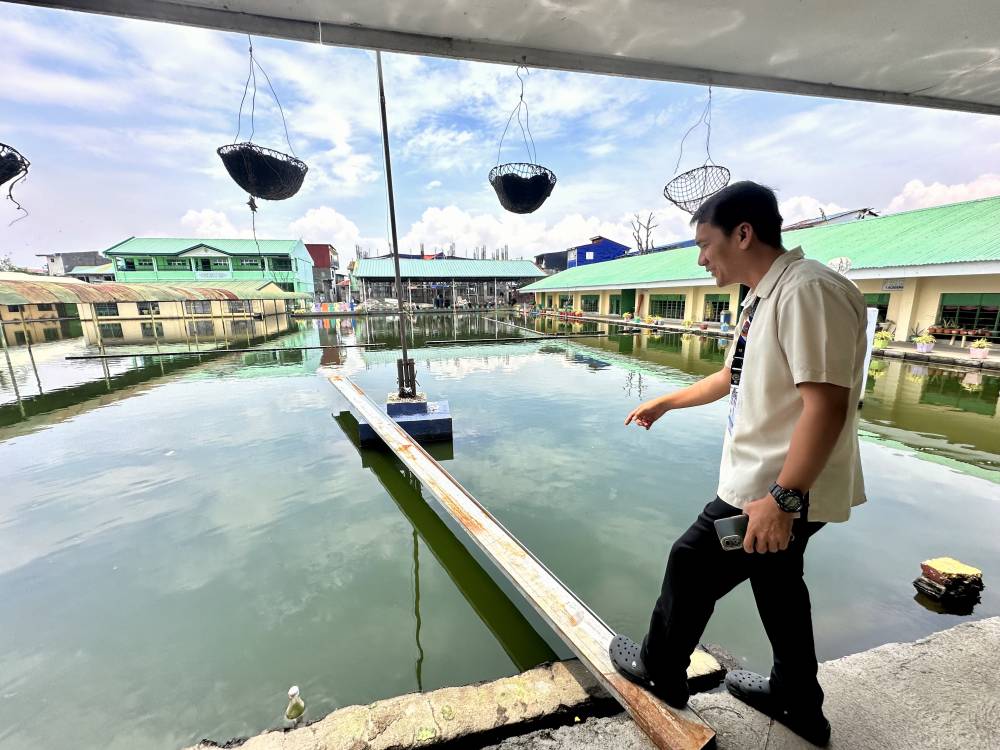High tide disrupts classes in Bulacan town, forcing schools to adjust

HAGONOY, BULACAN—School calendars in this coastal town at the mouth of Manila Bay are not just marked with class schedules and holidays; they also come with tide charts.
For many students here, the decision to attend in-person classes depends not only on the weather but on the height and timing of the daily high tide, which can submerge entire neighborhoods, including roads, homes and school grounds.
Because 7,000 hectares of Hagonoy’s 10,350-ha territory is lower than the sea level, most of the town’s grounds are inundated with seawater during high tide, explained Renato Crisostomo, the outgoing municipal disaster risk reduction management officer.
Hagonoy has two coastal island barangays—Pugad and Tibaguin. Its land villages—San Roque, Santa Cruz, San Pascual, Santo Rosario, Mercado, Santa Elena and Sagrada Familia are situated along the mouth of Manila Bay and are in less-than-a-kilometer’s distance to Manila Bay waters, added Crisostomo.
At least 15 schools across 15 villages in Hagonoy West District, including San Pascual, V.C. Raymundo, San Roque, Mercado, Sta. Monica, Tampok, San Nicolas, Don Miguel, Sagrada Familia, Sta. Elena, Buga, and Tibaguin Elementary Schools, face regular flooding from high tide.
When water creeps into classrooms and covers the roads, students shift to the Department of Education’s (DepEd) Alternative Delivery Mode, either online or modular.
While some schools like Hagonoy West Central, San Jose and San Nicolas have undergone upgrades to make facilities more resilient, the access roads leading to them remain prone to flooding.
On Wednesday, San Roque Elementary School’s officer in charge principal Jerald Bonustro was forced to cancel afternoon classes, anticipating the 3.38-foot high tide expected at 1:39 p.m.
Classes that started between 7:15 a.m. to 11:45 a.m. “had to [be] cut short so the children could get home before the floodwaters rise,” Bonustro told the Inquirer.
He noted that even an hour before the high tide, the roads leading to the school were also getting flooded.
Bonustro said students who have access to the internet attend classes online while others rely on printed modules. Teachers and school staff, meanwhile, remained in the flooded school to hand out modules and conduct online sessions.
Regular occurrence
Except for a newly constructed pathway, nearly all parts of San Roque Elementary School are regularly flooded.
“Without that pathway, we’d have no dry ground left,” Bonustro shared.
Ma. Victoria Pascual, who has taught at the school for 23 years, said conditions have worsened.
“When I started in 2002, the central grounds of the school stayed dry. Now, even that area floods,” she said.
Landfill
She attributed the worsening floods to clogged drainage systems and the rising ground levels of nearby roads and houses, which leave the school in a sunken state.
“We’ve become the neighborhood’s gutter,” Pascual lamented.
Despite some help from the village and the provincial government, including the construction of a new building, the school needs more landfill materials to raise its elevation.
Monica Perez, another school official, said full in-person classes are only possible from November to February, when high tides usually occur at night.
“The rest of the year, students are forced to learn remotely,” she said.
In Barangay San Sebastian, children had to ride bancas (small boats) to school on Monday, the opening day of classes, due to flooding.
Irene San Juan, principal of Hagonoy West Central School in Barangay Santo Rosario, said they are bracing for the possibility of class suspensions next week with tides expected to reach 5.2 feet.
“Some parents prefer their kids to stay in school during high tide, especially on the second floor, where it’s safer,” she said.
‘Disgusting’
Residents have learned to live with daily flooding, with much difficulty.
“Even if we’re used to it, it’s still difficult. When you wake up, your feet are already in cold, smelly water from the garbage. It’s disgusting,” said Valen Sebastian, 69, of Barangay San Sebastian, who accompanies her fifth-grade grandchild to Santiago Trillana Academy every day.
“The previous tide hasn’t even drained when the next one comes. It’s our own doing—throwing trash, clogging waterways. The government must desilt rivers and improve drainage,” she said.
Schools in Hagonoy East District—including those in Abulalas, Carillo, Iba, Iba-Ibayo, Palapat, Pugad, San Agustin, San Isidro, San Juan, San Miguel, and San Pablo—remain flood-free, according to Ma. Lourdes Patag, senior education program specialist and information officer for the DepEd Bulacan Schools Division.
According to Patag, there are about 90,000 students in 142 elementary and high schools in Bulacan that undergo a shifting schedule of classes because of high tide floods.
Councilor Dalisay Ople-San Jose said even upland areas like Barangay Palapat have recently reported flooding.
“When the water is high, children from villages near the Poblacion also struggle to get to school,” she said.
Crisostomo confirmed that high tide flooding now affects most of Hagonoy’s barangays.
According to Crisostomo, with the tides rising year after year, many here worry that “the worst is yet to come.”

















